fuel type CITROEN C4 2019 Owners Manual
[x] Cancel search | Manufacturer: CITROEN, Model Year: 2019, Model line: C4, Model: CITROEN C4 2019Pages: 317, PDF Size: 9.31 MB
Page 134 of 317
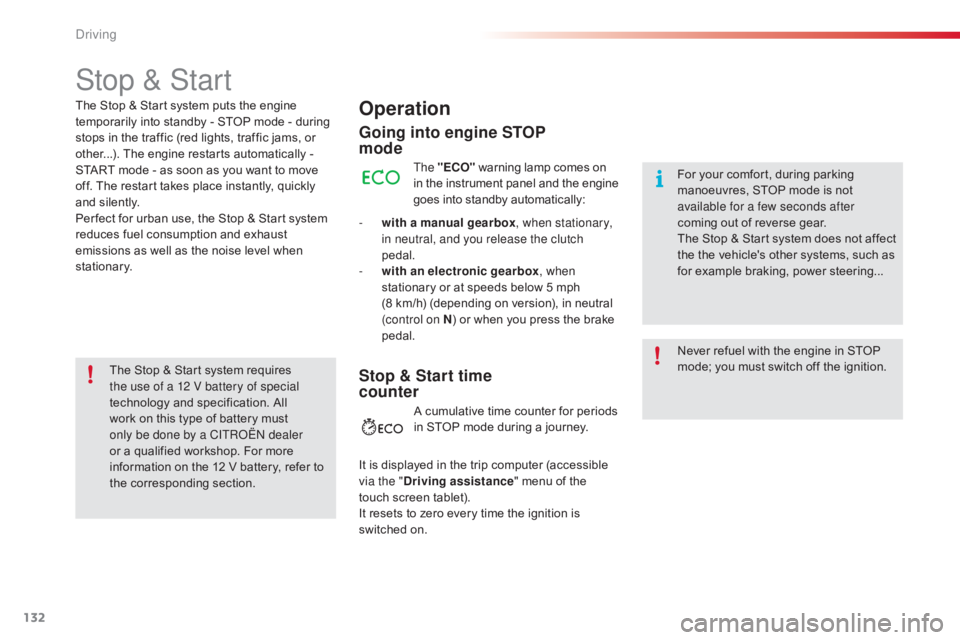
132
C4-cactus_en_Chap06_conduite_ed01-2016
Stop & Start
Operation
Going into engine STOP
mode
The "ECO" warning  lamp  comes  on i
n  the  instrument  panel  and  the  engine g
oes  into  standby  automatically:
-
w
ith a manual gearbox , when stationary,
in neutral, and you release the clutch
pedal.
-
w
ith an electronic gearbox , when
stationary
 or  at  speeds  below  5  mph Â
(
8 km/h)  (depending  on  version),  in  neutral Â
(
control on N )
 or  when  you  press  the  brake Â
ped
al. Never
 refuel  with  the  engine  in  STOP Â
m
ode;  you  must  switch  off  the  ignition.
For
 your  comfort,  during  parking Â
m
anoeuvres,  STOP  mode  is  not Â
a
vailable for a few seconds after
coming
 out  of  reverse  gear.
The
 Stop  &  Start  system  does  not  affect Â
t
he  the  vehicle's  other  systems,  such  as Â
f
or  example  braking,  power  steering...
The
Â
Stop
Â
&
Â
Start system
Â
puts
Â
the
Â
engine
Â
t
emporarily
Â
into
Â
standby
Â
-
Â
STOP
Â
mode
Â
-
Â
during
Â
s
tops
Â
in
Â
the
Â
traffic
Â
(red
Â
lights,
Â
traffic
Â
jams,
Â
or
 o
ther...).
Â
The
Â
engine
Â
restarts
Â
automatically
Â
-
 S
TART
Â
mode
Â
-
Â
as
Â
soon
Â
as
Â
you
Â
want
Â
to
Â
move
Â
o
ff.
Â
The
Â
restart
Â
takes
Â
place
Â
instantly,
Â
quickly
Â
a
nd
Â
silently.
Per fect
Â
for
Â
urban
Â
use,
Â
the
Â
Stop
Â
&
Â
Start
Â
system
Â
r
educes
Â
fuel
Â
consumption
Â
and
Â
exhaust
Â
e
missions
Â
as
Â
well
Â
as
Â
the
Â
noise
Â
level
Â
when
Â
s
tationary.
Stop & Start time
counter
A cumulative time counter for periods i n  STOP  mode  during  a  journey.
It
Â
is
Â
displayed  in  the  trip  computer  (accessible Â
v
ia the " Driving assistance "
 menu  of  the Â
t
ouch
Â
screen  tablet).
It
Â
resets
Â
to  zero  every  time  the  ignition  is Â
s
witched
Â
on.
The
Â
Stop
Â
&
Â
Start
Â
system
Â
requires
Â
t
he use of a 12 V battery of special
technology
Â
and
Â
specification.
Â
All
 w
ork
Â
on
Â
this
Â
type
Â
of
Â
battery
Â
must
Â
o
nly be done by a CITROĂ‹N dealer
or
Â
a
Â
qualified
Â
workshop.
Â
For
Â
more
Â
i
nformation
Â
on
Â
the
Â
12
Â
V
Â
battery,
Â
refer
Â
to
Â
t
he
Â
corresponding
Â
section.
Driving
Page 155 of 317

153
C4-cactus_en_Chap07_info-pratiques_ed01-2016
Fuel tank
Capacity of the tank:
- Pe trol:  approximately  50  litres.
-
Â
D
iesel:  approximately  45  or  50  litres  (depending  on  version).
Low fuel levelRefuelling
When the low fuel level is reached,
this
 warning  lamp  in  the  instrument Â
p
anel  comes  on,  accompanied  by Â
a
n  audible  warning,  a  message  and Â
t
he  last  bar  of  the  fuel  gauge  flashes Â
i
n  red.
To
 refuel  in  complete  safety:
F
Y
ou must switch off the engine.
F
Â
O
pen  the  filler  flap.
A label on the inside of the fuel filler flap
reminds
 you  of  the  type  of  fuel  to  use, Â
d
epending  on  your  engine  type.
Additions
 of  fuel  must  be  of  at  least  5  litres  to Â
b
e  registered  by  the  fuel  gauge.
When
Â
it
Â
first  comes  on,  about 5 litres of fuel
remain
Â
in
Â
the  tank.
Until sufficient fuel has been added, this
warning
Â
lamp  appears  every  time  the  ignition Â
i
s
Â
switched  on,  accompanied  by  an  audible Â
w
arning
Â
and  a  message.  This  audible  warning Â
a
nd
Â
message  are  repeated  with  increasing Â
f
requency
 as  the  fuel  level  drops  towards  "0 ".
Refuel
Â
as
 soon  as  possible  to  avoid  running Â
o
ut. Opening
 the  filler  cap  may  result  in  an  inrush  of Â
a
ir.  This  is  entirely  normal  and  results  from  the Â
s
ealing  of  the  fuel  system.
With Stop & Start, never refuel with the
system
 in  STOP  mode;  you  must  switch Â
o
ff  the  ignition  with  the  key.
For
 more  information  on  running  out  of Â
f
uel  (Diesel),  refer  to  the  corresponding Â
s
ection. F
Â
T
ake  care  to  select  the  pump  that  delivers Â
t
he  correct  type  of  fuel  for  your  vehicle.
F
Â
I
ntroduce  the  key  into  the  cap  and  turn  it  to Â
t
he  left.
7
Practical information
Page 157 of 317
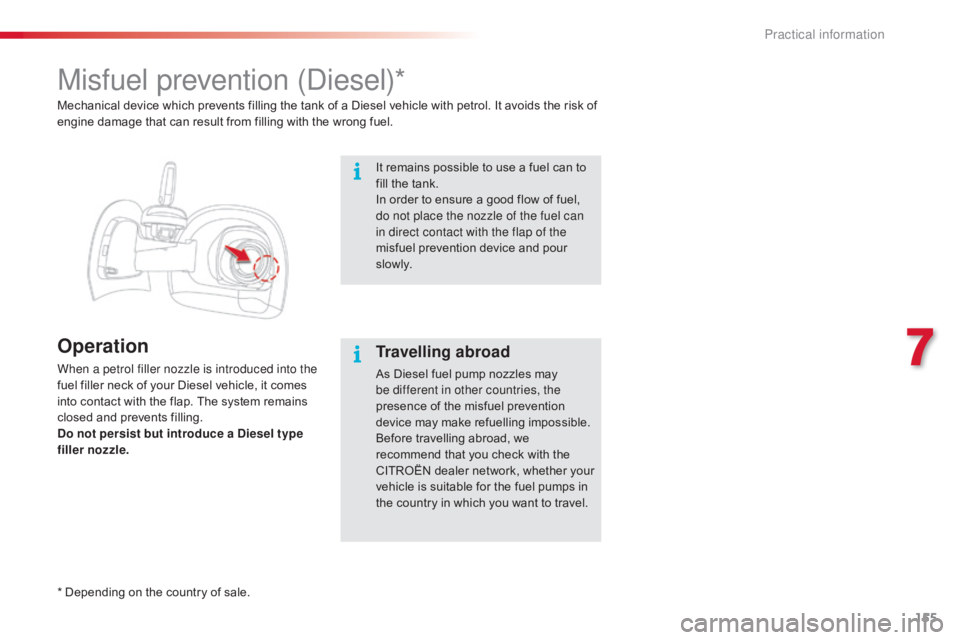
155
C4-cactus_en_Chap07_info-pratiques_ed01-2016
Misfuel prevention (Diesel)*
Operation
When a petrol filler nozzle is introduced into the
fuel filler  neck  of  your  Diesel  vehicle,  it  comes Â
i
nto  contact  with  the  flap.  The  system  remains Â
c
losed  and  prevents  filling.
Do not persist but introduce a Diesel type
filler nozzle.
*
 Depending  on  the  country  of  sale.
Mechanical
 device  which  prevents  filling  the  tank  of  a  Diesel  vehicle  with  petrol.  It  avoids  the  risk  of Â
e
ngine  damage  that  can  result  from  filling  with  the  wrong  fuel.
It  remains  possible  to  use  a  fuel  can  to Â
f
ill  the  tank.
In  order  to  ensure  a  good  flow  of  fuel, Â
d
o not place the nozzle of the fuel can
in direct contact with the flap of the
misfuel  prevention  device  and  pour Â
s
l ow l y.Travelling abroad
As Diesel fuel pump nozzles may b
e different in other countries, the
presence
 of  the  misfuel  prevention Â
d
evice  may  make  refuelling  impossible.
Before
 travelling  abroad,  we Â
r
ecommend  that  you  check  with  the Â
C
ITROĂ‹N  dealer  network,  whether  your Â
v
ehicle  is  suitable  for  the  fuel  pumps  in Â
t
he  country  in  which  you  want  to  travel.
7
Practical information
Page 158 of 317
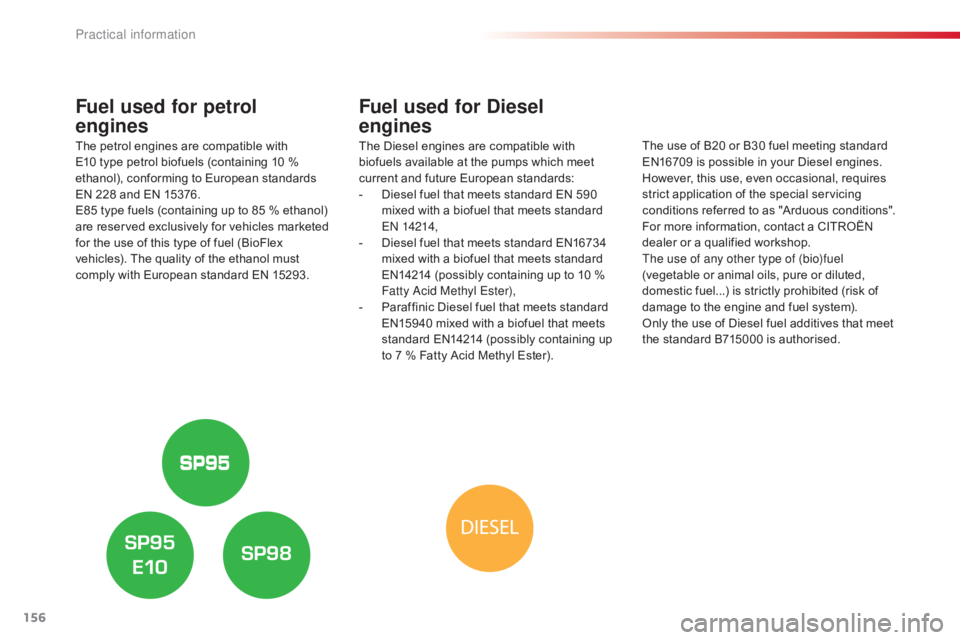
156
C4-cactus_en_Chap07_info-pratiques_ed01-2016
Fuel used for petrol
engines
The petrol engines are compatible with E
10 type  petrol  biofuels  (containing  10  % Â
e
thanol),  conforming  to  European  standards Â
E
N  228  and  EN  15376.
E85
 type  fuels  (containing  up  to  85  %  ethanol) Â
a
re  reserved  exclusively  for  vehicles  marketed Â
f
or  the  use  of  this  type  of  fuel  (BioFlex Â
v
ehicles).  The  quality  of  the  ethanol  must Â
c
omply  with  European  standard  EN  15293.
Fuel used for Diesel
engines
The Diesel engines are compatible with biofuels  available  at  the  pumps  which  meet Â
c
urrent  and  future  European  standards:
-
Â
D
iesel  fuel  that  meets  standard  EN  590 Â
m
ixed  with  a  biofuel  that  meets  standard Â
E
N 14214,
-
Â
D
iesel  fuel  that  meets  standard  EN16734 Â
m
ixed  with  a  biofuel  that  meets  standard Â
E
N14214  (possibly  containing  up  to  10  % Â
F
atty Acid Methyl Ester),
-
Â
P
araffinic  Diesel  fuel  that  meets  standard Â
E
N15940  mixed  with  a  biofuel  that  meets Â
s
tandard  EN14214  (possibly  containing  up Â
t
o  7  %  Fatty  Acid  Methyl  Ester).The
 use  of  B20  or  B30  fuel  meeting  standard  E
N16709  is  possible  in  your  Diesel  engines. Â
H
owever,  this  use,  even  occasional,  requires Â
s
trict  application  of  the  special  servicing Â
c
onditions  referred  to  as  "Arduous  conditions". Â
F
or  more  information,  contact  a  CITROĂ‹N Â
d
ealer  or  a  qualified  workshop.
The use of any other type of (bio)fuel
(vegetable
 or  animal  oils,  pure  or  diluted, Â
d
omestic  fuel...)  is  strictly  prohibited  (risk  of Â
d
amage  to  the  engine  and  fuel  system).
Only
 the  use  of  Diesel  fuel  additives  that  meet Â
t
he  standard  B715000  is  authorised.
Practical information
Page 221 of 317

219
C4-cactus_en_Chap09_caracteristiques-techniques_ed01-2016
EnginePureTech 75PureTech 82PureTech 82 S&S PureTech 110 S&S
Gearbox Manual
(5-speed) Manual
(5-speed) ETG electronic
(5-speed) Manual
(5-speed)
Model code 0PHMU0PHMZ0PHNZ
Cubic capacity (cc) 1
 1991
 1991
 199
Bore
 x  stroke  (mm) 75
 x  90.575
 x  90.575
 x  90.5
Max
 power:  EU  standard  (kW)* 55 60 81
Max
 power  engine  speed  (rpm) 5
 7505
 7505
 500
Max
 torque:  EU  standard  (Nm) 11 6 118205
Max
 torque  engine  speed  (rpm) 2
 7502
 7501
 500
Fuel UnleadedUnleadedUnleaded
Catalytic converter yesyesyes
Engine
 oil  capacity  with  replacement  of  the  oil Â
f
ilter (in litres) 3.25
3.25 3.5
*
 Â
T
he  maximum  power  corresponds  to  the  type  approved  value  on  a  test  bed,  under  conditions  defined  by  European  legislation Â
(directive
 1
999/99/EC).
Engines and gearboxes - PETROL
9
Technical data
Page 223 of 317
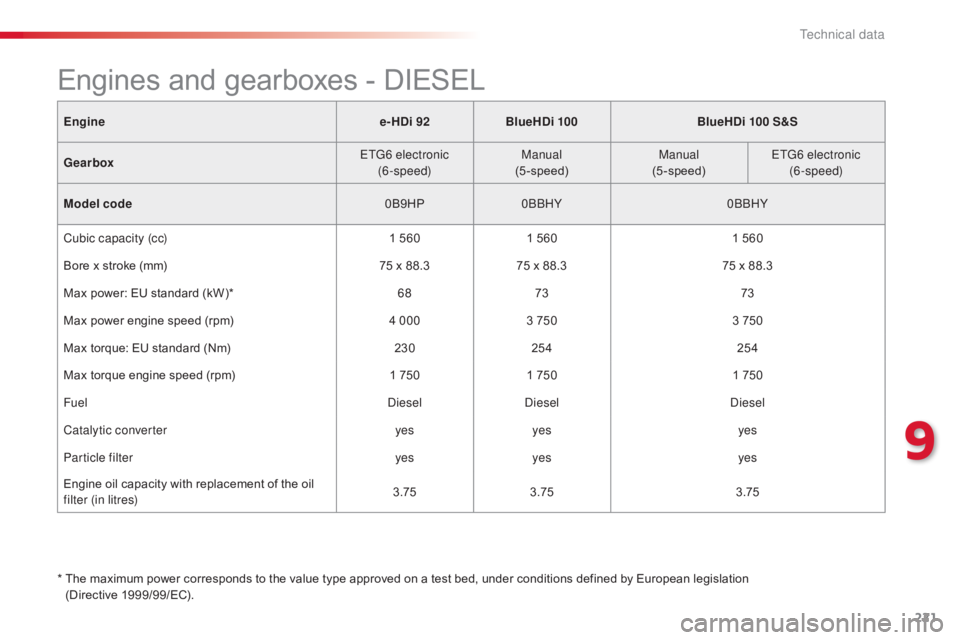
221
C4-cactus_en_Chap09_caracteristiques-techniques_ed01-2016
Enginee-HDi 92BlueHDi 100 BlueHDi 100 S&S
Gearbox ETG6 electronic
(6-speed) Manual
(5-speed) Manual
(5-speed) ETG6 electronic
(6-speed)
Model code 0B9HP0BBHY 0BBHY
Cubic capacity (cc) 1
 5601
 5601
 560
Bore
 x  stroke  (mm) 75
 x  88.375
 x  88.375
 x  88.3
Max
 power:  EU  standard  (kW)* 6873 73
Max
 power  engine  speed  (rpm) 4 0003
 7503
 750
Max
 torque:  EU  standard  (Nm) 230254 254
Max
 torque  engine  speed  (rpm) 1
 7501
 7501
 750
Fuel DieselDiesel Diesel
Catalytic converter yesyes yes
Particle filter yesyes yes
Engine
 oil  capacity  with  replacement  of  the  oil Â
f
ilter (in litres) 3.75
3.75 3.75
*
 Â
T
he  maximum  power  corresponds  to  the  value  type  approved  on  a  test  bed,  under  conditions  defined  by  European  legislation Â
(Directive
 1
999/99/EC).
Engines and gearboxes - DIESEL
9
Technical data
Page 226 of 317

224
C4-cactus_en_Chap09_caracteristiques-techniques_ed01-2016
Identification markingsVarious visible markings for the identification of your vehicle.
A.
V
ehicle Identification Number (VIN)
under the bonnet.
 T
his  number  is  engraved  on  the  chassis Â
n
ear  the  right  hand  front  wheel  arch. The
 tyre  pressures  must  be  checked Â
w
hen the tyres are cold, at least once
a
 month.
If the tyre pressures are too low, this
increases
 fuel  consumption.
C.
M
anufacturer's label.
 T
his  self-destroying  label  on  the  middle Â
d
oor  pillar,  right  or  left  hand  side,  contains Â
th
e
 f
ollowing
 i
nformation:
-
Â
t
he  manufacturer's  name,
-
t
he European whole vehicle type
approval
 number,
-
Â
t
he  vehicle  identification  number  (VIN),
-
Â
t
he  maximum  authorised  weight  (gross Â
ve
hicle
 w
eight),
-
Â
t
he  maximum  authorised  weight  with Â
t
railer  (gross  train  weight),
-
Â
t
he  maximum  front  axle  weight,
-
Â
t
he  maximum  rear  axle  weight.D.
T
yre/paint label.
 T
his  label  on  the  middle  door  pillar,  driver's Â
s
ide,  contains  the  following  information:
-
t
he tyre inflation pressures, laden and
unladen,
-
Â
t
he  tyre  sizes  (including  the  tyre  load Â
i
ndex  and  speed  rating),
-
t
he inflation pressure for the spare
wheel,
-
Â
t
he  paint  colour  code.
B.
V
ehicle Identification Number (VIN) on
the windscreen lower cross member.
 T
his  number  is  indicated  on  a  self-
adhesive
 label  which  is  visible  through Â
t
he windscreen.
Technical data
Page 309 of 317
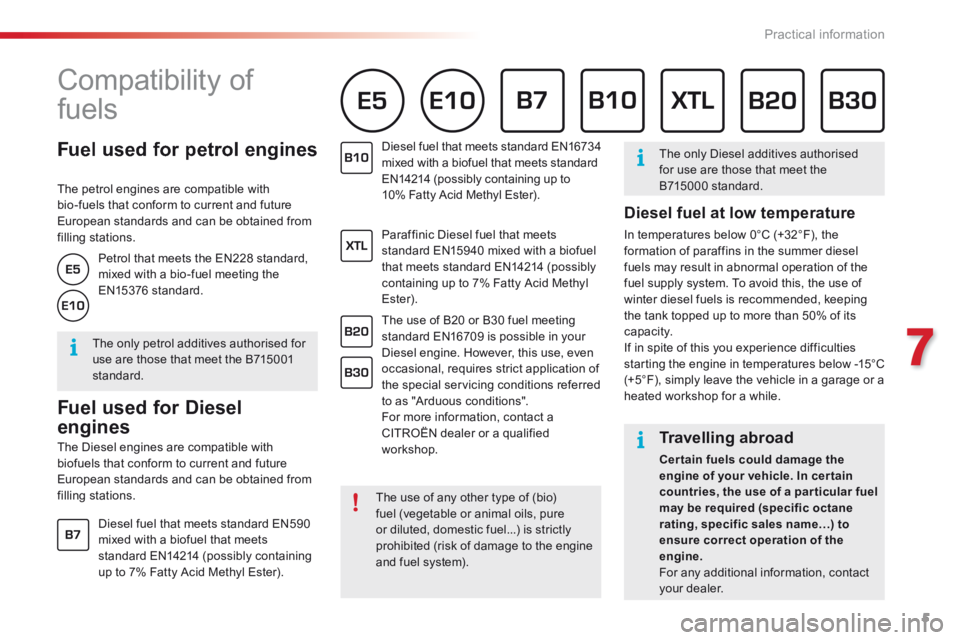
5
7
Practical information
Fuel used for petrol engines
The petrol engines are compatible with bio-fuels that conform to current and future European standards and can be obtained from filling stations.
Fuel used for Diesel
engines
The Diesel engines are compatible with biofuels that conform to current and future European standards and can be obtained from filling stations.
Diesel fuel that meets standard EN590 mixed with a biofuel that meets standard EN14214 (possibly containing up to 7% Fatty Acid Methyl Ester).
Diesel fuel that meets standard EN16734 mixed with a biofuel that meets standard EN14214 (possibly containing up to 10% Fatty Acid Methyl Ester).
Paraffinic Diesel fuel that meets standard EN15940 mixed with a biofuel that meets standard EN14214 (possibly containing up to 7% Fatty Acid Methyl Ester).
The use of B20 or B30 fuel meeting standard EN16709 is possible in your Diesel engine. However, this use, even occasional, requires strict application of the special servicing conditions referred to as "Arduous conditions". For more information, contact a CITROĂ‹N dealer or a qualified workshop.
The use of any other type of (bio)fuel (vegetable or animal oils, pure or diluted, domestic fuel...) is strictly prohibited (risk of damage to the engine and fuel system).
The only petrol additives authorised for use are those that meet the B715001 standard.
Travelling abroad
Cer tain fuels could damage the engine of your vehicle. In cer tain countries, the use of a par ticular fuel may be required (specific octane rating, specific sales name…) to ensure correct operation of the engine. For any additional information, contact
your dealer.
The only Diesel additives authorised for use are those that meet the B715000 standard.
Petrol that meets the EN228 standard, mixed with a bio-fuel meeting the EN15376 standard.
Compatibility of
fuels
Diesel fuel at low temperature
In temperatures below 0°C (+32°F), the formation of paraffins in the summer diesel fuels may result in abnormal operation of the fuel supply system. To avoid this, the use of winter diesel fuels is recommended, keeping the tank topped up to more than 50% of its capacity. If in spite of this you experience difficulties starting the engine in temperatures below -15°C (+5°F), simply leave the vehicle in a garage or a heated workshop for a while.